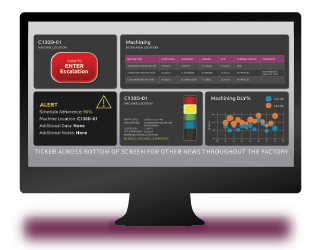 How reducing forecasting errors and disruption risks create better supplier relationships.
How reducing forecasting errors and disruption risks create better supplier relationships.
Building trust in the supply chain is essential to driving flow; and when there are forecast errors, there is an inherent mistrust throughout the supply chain. Lack of collaboration is often the cornerstone of conflict, blame, and mistrust between a manufacturer and suppliers. Missed shipments tend to lead to finger-pointing, followed by over-buffering on both sides to guard against further disruptions, which often results in further exacerbation of the negative bull-whip effect.
Cost-effective supply chain collaboration between manufacturer and suppliers is paramount. Without that constraint addressed, all other benefits are pointless.
Start with right-sizing inventory and just-in-time replenishment practices.
In a recent issue of Financial Director, editorial contributors Paul Dennis and Peter Young, suggested if there is one thing about predicting the future that always comes true, it’s that everyone, from time to time, gets things wrong. It is safe to say that with forecasts, they can be relatively accurate at a high level (i.e. total sales, sales for product type, etc), but at a low level like sales for an individual for the week 40 is near impossible. However, this is where the relationship between manufacturer and suppliers exists. The article argues that what separates best-in-class companies  from those that struggle with accuracy is how they root out (and learn from) forecasting errors.
from those that struggle with accuracy is how they root out (and learn from) forecasting errors.
From an inventory perspective, today more manufacturers are viewing excessive inventory as a huge financial liability rather than an asset. Best-in-class demand-driven manufacturers successfully combat this risk through “right-sizing” inventory and stock buffers using pull-based or demand-driven replenishment solutions. This methodology greatly reduces reliance on forecast and therefore reduces the impact of forecast error. A common and highly effective way to implement a demand-driven methodology is through an electronic Kanban system.
In leveraging an eKanban system, manufacturers and supply chain professionals start driving good replenishment signals to the supplier, fostering trust and reducing noise. eKanban systems automate inventory replenishment by sending suppliers real-time demand signals and enable collaboration by providing both parties with online visibility into order and fulfillment status. How does real-time collaboration and visibility impact the financial statements and key performance indicators? Case in point: In their first year on an eKanban system, plastics manufacturer, Dynisco, saved over $985,000.00 in inventory costs, just by right-sizing. (See article in Plant Services magazine.)
Create a collaborative, transparent environment for all suppliers.
“From Superstorms to Factory Fires: Managing Unpredictable Supply Chain Disruptions,” was a feature article published in Harvard Business Review by David Simchi-Levi, William Schmidt, and Yehua Wei. They suggested that leaders using traditional risk-management techniques and simple heuristics (dollar amount spent at a site, for instance) often end up focusing exclusively on the so-called strategic suppliers for whom expenditures are very high and whose parts are deemed crucial to product differentiation, and overlooking the risks associated with low-cost, commodity suppliers. The fact is, a lack of collaboration with any supplier introduces an element of risk including disruptions to flow that impact throughput. And, a lack of visibility across the supply chain network results in managers taking the wrong actions, wasting resources, and leaving the organization exposed to hidden risk. Demand or Pull-based manufacturing is a method that allows companies to identify, manage, and reduce exposure to supply chain risks by creating transparency.
We define Pull-based or Demand-Driven Manufacturing as a method of manufacturing where production is based on actual customer demand rather than a forecast – and where all layers of manufacturing are synchronized (people, process, materials, machines, and information) to drive flow. This process is accelerated by technology that automates, digitizes data and connects every function within the demand-driven organization to every layer of the supply chain. Gartner estimates that 90% of manufacturers who are not truly demand-driven, want to be. This is likely due to the many benefits demand-driven manufacturing offers, including greater customer – and supplier – satisfaction.
Environments for Demand-Driven Manufacturing
Demand-driven principles can be used in nearly every manufacturing environment because the focus is on flow through the factory. In make-to-stock (MTS) environments, a demand-driven manufacturing platform can drive immediate improvements by right-sizing inventory, increasing flow and throughput, and replenishing resources using an eKanban system. These improvements can be extended across the entire supply chain. In make-to-order (MTO), engineer-to-order (ETO), and configure-to-order (CTO) environments, a synchronized demand-driven manufacturing planning, scheduling, and execution approach manages constraints to deliver increased flow, throughput, on-time delivery, and clarity throughout the manufacturing process and the extended supply chain.
In any environment, the aim of a demand-driven system is to synchronize all layers of manufacturing to drive flow. Order statuses (and any associated disruptions) are visible throughout the enterprise – to the production team, supply chain management, customer service, sales, leadership – and suppliers. Everyone is working from the same factual, real-time information. Trust is built from a single version of the truth gained through shared visibility and collaboration.
Additional resources:
White Paper: Gaining Confidence: Syncing Supplier Delivery to Customer Demand
Article: What is Demand-Driven Manufacturing?
Case Study: Continuous Improvement Immersion + the Right Tools Proves Profitable for Dynisco










